Beef Bulgogi
This post may contain affiliate links. Read my full disclosure policy.
Add some sizzle to your weeknights with this easy beef bulgogi recipe—a Korean barbecue favorite!
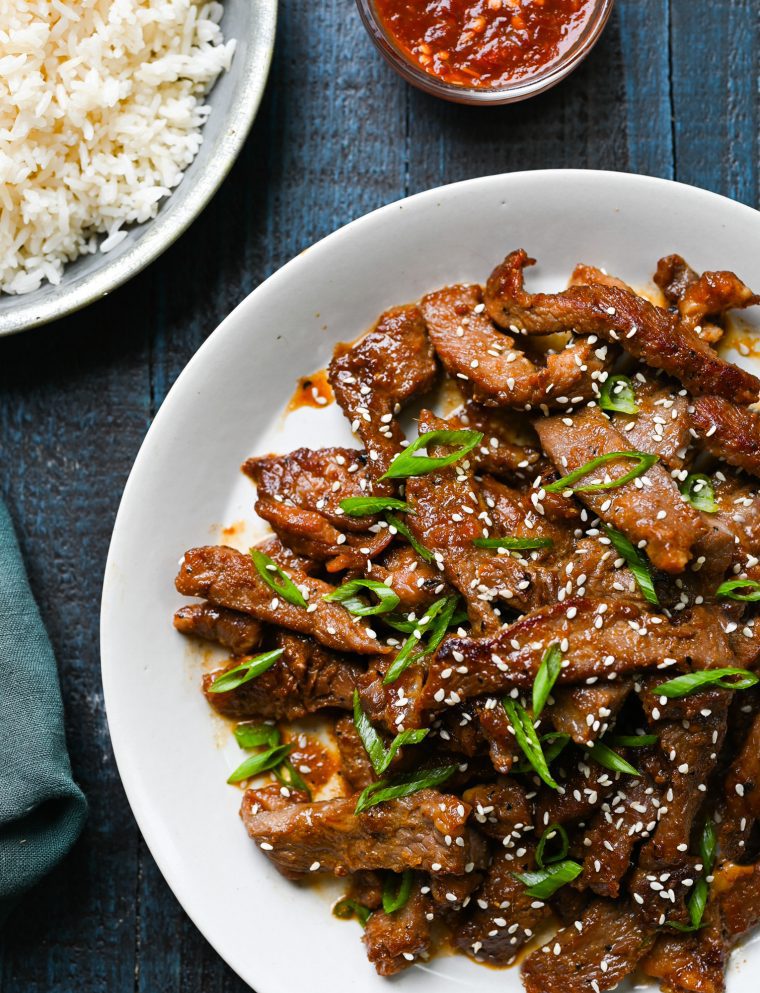
Bulgogi, pronounced bool-goh-gee, is a popular Korean barbecue dish that translates to “fire meat.” It’s made of thinly sliced marinated meat, typically beef, that’s grilled on a barbecue or stovetop griddle. Despite its name, bulgogi is not really spicy — “fire” refers to the hot cooking surface. In many Korean restaurants, tables are outfitted with grills in the center so customers can cook the bulgogi meat themselves and eat it straight from the grill. Bulgogi is typically served with steamed rice, lettuce wraps, chili sauce, and other traditional Korean accompaniments.
Making bulgogi at home is surprisingly easy. In this version, adapted from Cooks Illustrated, I marinate well-marbled ribeye in a mixture of soy sauce, brown sugar, sesame oil, garlic, shallot, ginger, and red pepper flakes. Because the meat is thinly sliced, it only needs one hour to marinate (although it’s fine to leave it overnight, too). Instead of grilling the meat, which can be tricky unless you have a flat-top grill, I cook it in a cast iron or nonstick pan. Heads up: the mouthwatering smell of bulgogi sizzling on the stove will have your family circling the kitchen like hungry wolves. Conveniently, it cooks in under 10 minutes, so no one will have to wait too long!
Table of Contents
“Made it to the recipe but doubled the marinade as one reviewer suggested. Wow! This recipe is delicious!! Served it with some Jasmine rice and I can’t wait to make it again!!”
What You’ll Need To Make Beef Bulgogi
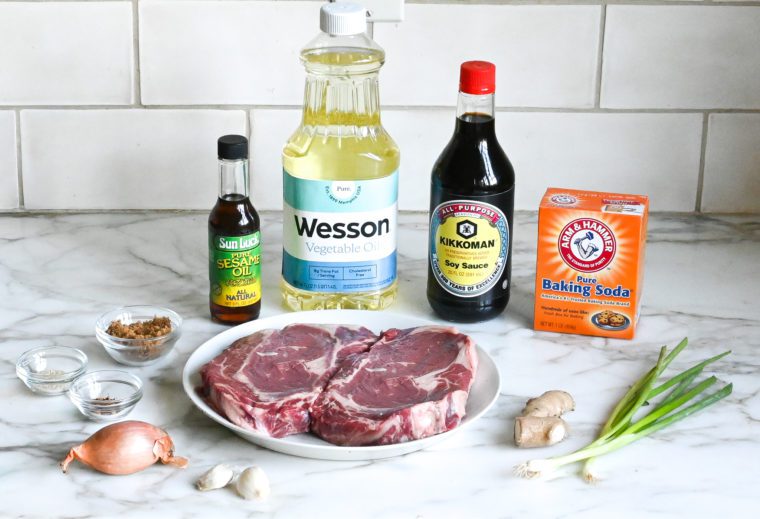
- Ribeye Steaks: Bulgogi can be made with many cuts of meat, including ribeye, short ribs, sirloin, or tenderloin. Ribeye is ideal as it’s well-marbled with fat, making it tender and tasty.
- Baking Soda: Tenderizes the beef and also helps with browning and caramelization.
- Vegetable Oil: The neutral base of the marinade.
- Asian Sesame Oil: A small amount adds a nutty, rich flavor to the marinade.
- Soy Sauce: Flavors the marinade with umami and saltiness, which deeply seasons the meat.
- Dark Brown Sugar: Adds sweetness to the marinade, balancing the salty flavors of the soy sauce and enhancing the caramelization of the meat when cooked.
- Garlic, Shallots, and Ginger: These aromatics contribute depth and complexity to the marinade, infusing the meat with traditional Korean flavors.
- Crushed Red Pepper Flakes: Introduce a hint of heat to the dish.
- Scallions: A fresh, crisp garnish that adds both color and a mild oniony flavor to complement the rich meat.
- Sesame Seeds: Finishes the dish with a slight crunch and reinforces the sesame flavor in the dish.
- Jump to the printable recipe for precise measurements
Step-By-Step Instructions
If time allows, place the steaks on a large plate and freeze until semi-firm, about 35 minutes. This makes the steaks much easier to slice. Slice the steaks into ¼-inch-thick slices.
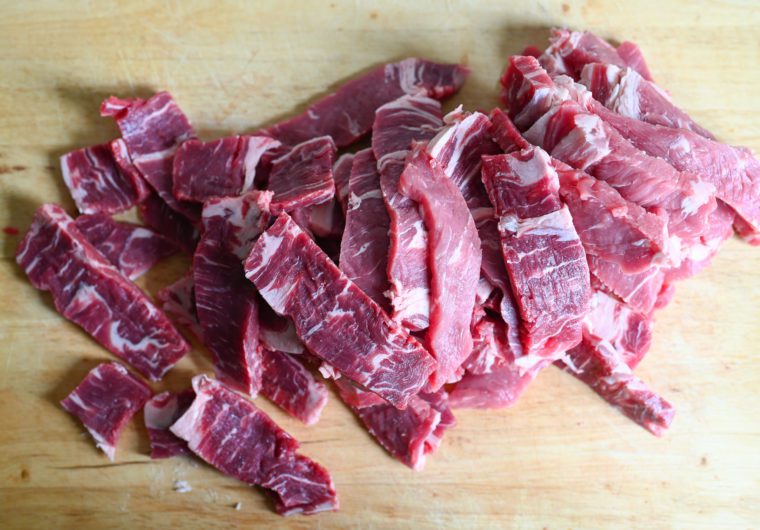
Combine 1½ tablespoons of water and the baking soda in a medium bowl. The baking soda acts as a tenderizer, and also helps with browning and caramelization. Add the beef slices and toss to coat. Let sit at room temperature for 5 minutes.
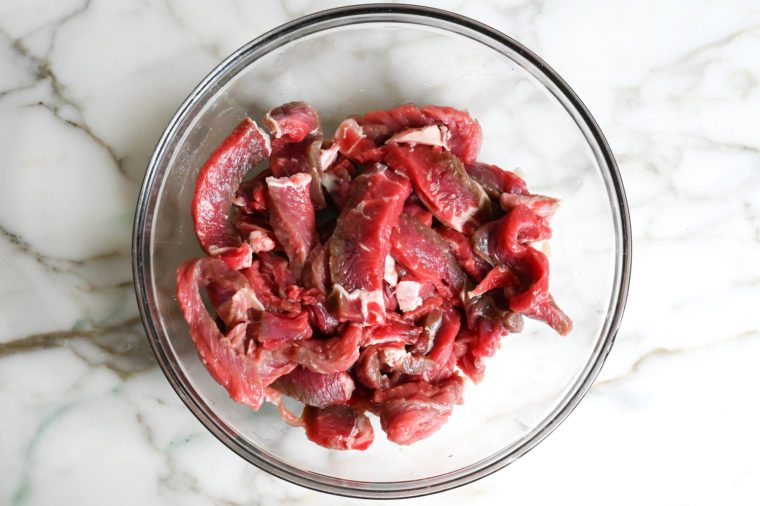
Meanwhile, in a mini food processor or blender, combine the vegetable oil, sesame oil, soy sauce, sugar, garlic, shallot, ginger, and red pepper flakes.
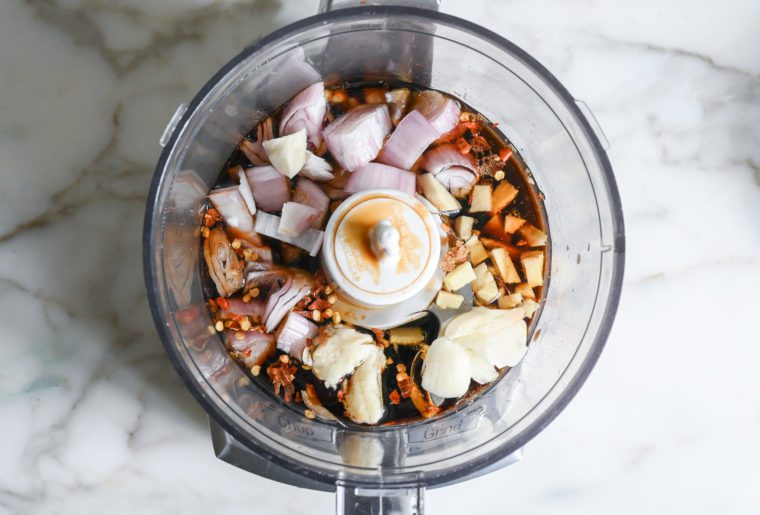
Process until smooth.
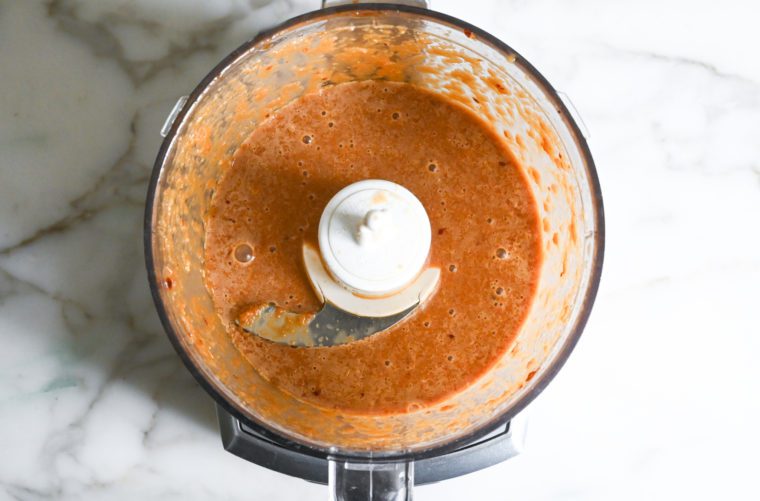
Pour the mixture over the beef and toss to coat evenly. Cover with plastic wrap and marinate in the refrigerator for at least 1 hour or overnight.
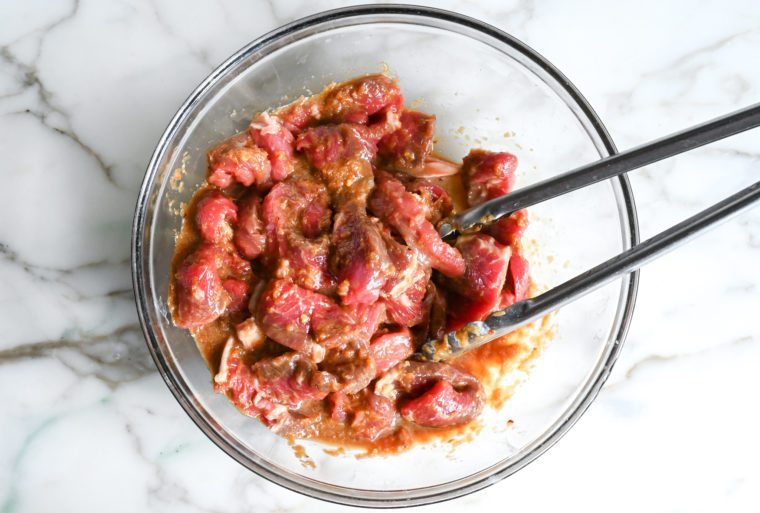
Turn on the exhaust fan. In a large (12-inch) cast iron or nonstick skillet over medium-high heat, heat the remaining 2 teaspoons of oil until very hot and shimmering. Your pan should be hot enough so that you hear a sizzling sound as the meat touches the pan. This helps the exterior of the meat caramelize while keeping the inside tender and juicy. Add half of the beef slices in a single layer and cook, without stirring, until browned on one side, 2 to 3 minutes.
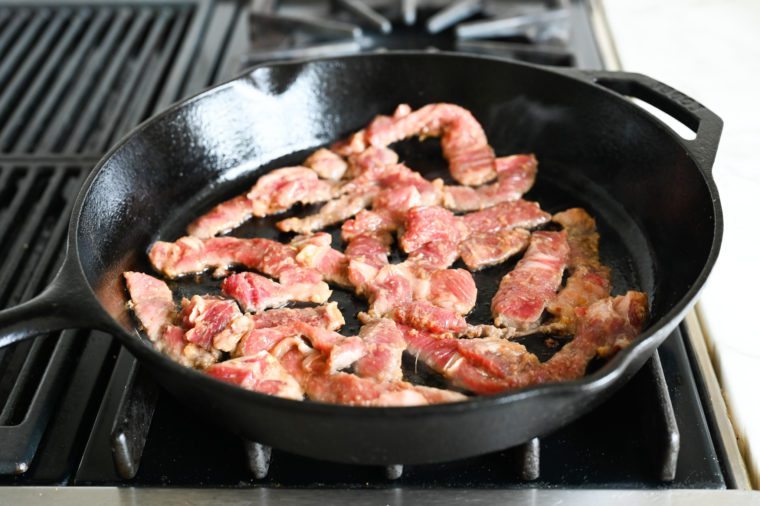
Stir the meat and continue stir-frying until the beef is just cooked through, 1 to 2 minutes longer. Transfer the beef to a serving platter and cover to keep warm; repeat with the remaining beef (no need to add more oil to the pan), adding any marinade left in the bowl to the pan right before stirring the meat.
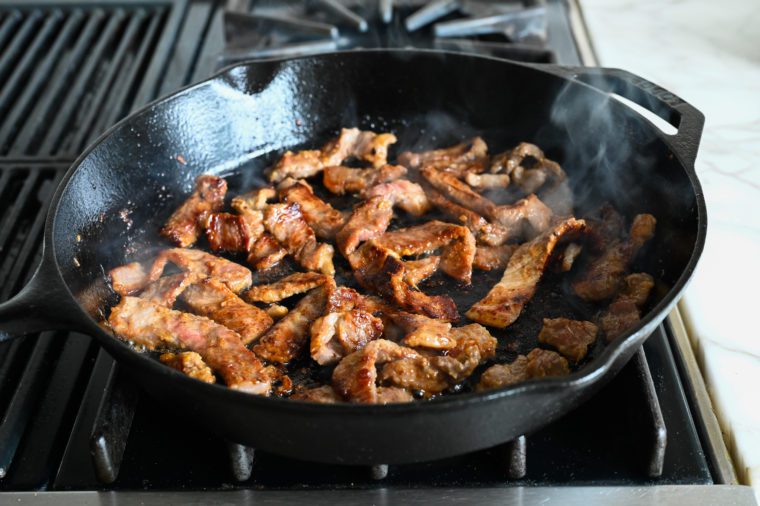
Transfer the second batch of beef to the serving platter and sprinkle with the scallion greens and sesame seeds. Serve immediately.
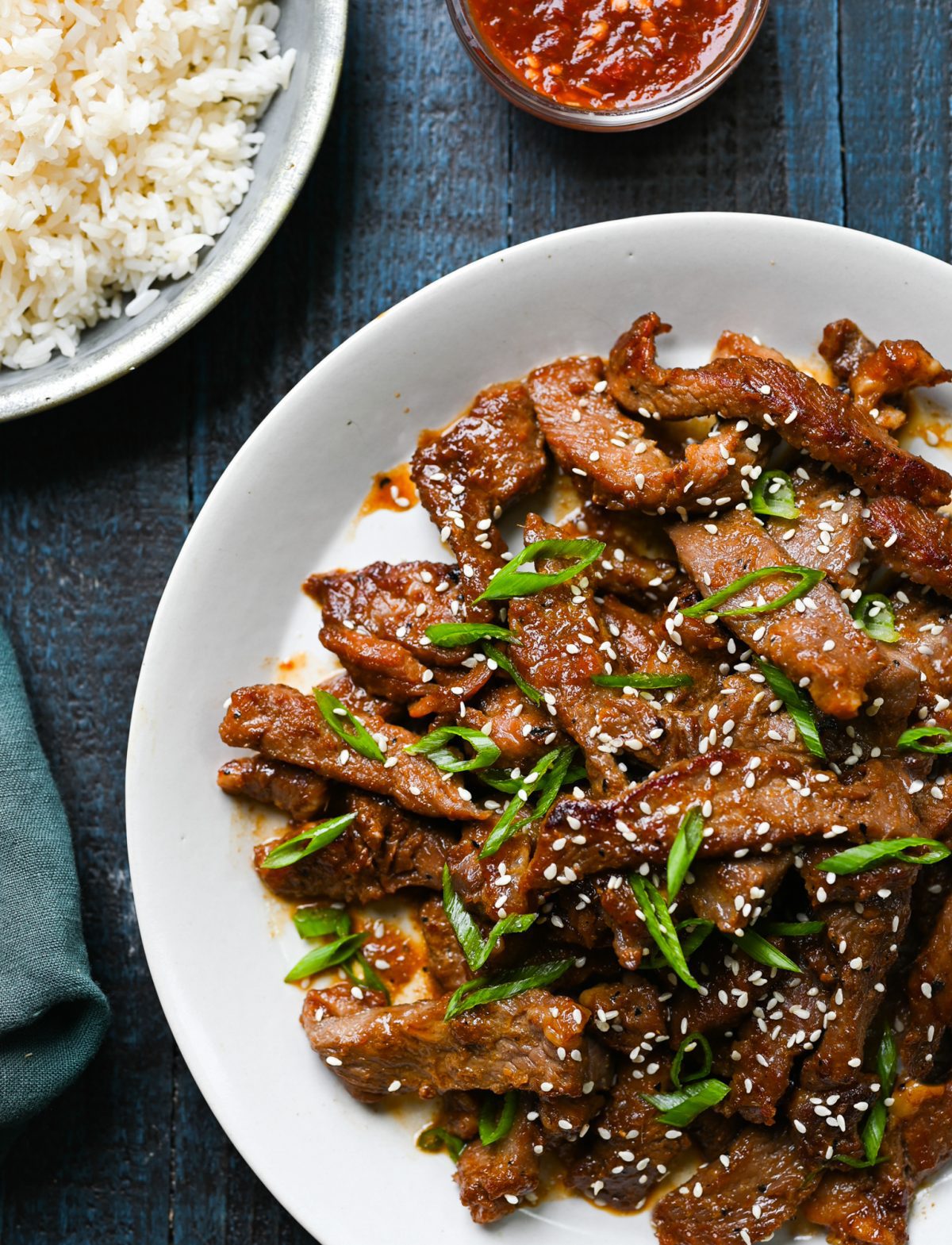
Video Tutorial
You May Also Like
Beef Bulgogi
Add some sizzle to your weeknights with this easy beef bulgogi recipe—a Korean barbecue favorite!
Ingredients
- 1¾-2 pounds ribeye steaks
- Heaping ¼ teaspoon baking soda
- 1½ tablespoons vegetable oil, plus 2 teaspoons more for cooking
- 1½ teaspoons Asian sesame oil
- ¼ cup soy sauce
- 3 tablespoons (packed) dark brown sugar
- 2 cloves garlic, roughly chopped
- 1 small shallot, roughly chopped
- 1 tablespoon roughly chopped fresh ginger, from a 1-inch knob (see note)
- Heaping ¼ teaspoon crushed red pepper flakes
- 2 scallions, dark green parts only, thinly sliced, for serving
- 1 teaspoon sesame seeds, for serving
Instructions
- If time allows, place the steaks on a large plate and freeze until semi-firm, about 35 minutes (this makes them easier to slice). Slice the steaks into ¼-inch-thick slices.
- Combine 1½ tablespoons of water and the baking soda in a medium bowl. Add the beef slices and toss to coat. Let sit at room temperature for 5 minutes.
- Meanwhile, in a mini food processor or blender, combine the 1½ tablespoons vegetable oil, sesame oil, soy sauce, sugar, garlic, shallot, ginger, and red pepper flakes; process until smooth. Pour the mixture over the beef and toss to coat evenly. Cover with plastic wrap and marinate in the refrigerator for at least 1 hour or overnight.
- Turn on the exhaust fan. In a large (12-inch) cast iron or nonstick skillet over medium-high heat, heat the remaining 2 teaspoons of oil until very hot and shimmering. Add half of the beef slices in a single layer and cook, without stirring, until browned on one side, 2 to 3 minutes. Stir the meat and continue stir-frying until the beef is just cooked through, 1 to 2 minutes longer. Transfer the beef to a serving platter and cover to keep warm; repeat with the remaining beef (no need to add more oil to the pan), adding any marinade left in the bowl to the pan right before stirring the meat. Transfer the second batch of beef to the serving platter and sprinkle with the scallion greens and sesame seeds. Serve immediately.
- Note: Check out easy guidance on how to peel, grate, and chop fresh ginger here.
Pair with
Nutrition Information
Powered by ![]()
- Per serving (4 servings)
- Calories: 707
- Fat: 55 g
- Saturated fat: 21 g
- Carbohydrates: 14 g
- Sugar: 11 g
- Fiber: 1 g
- Protein: 44 g
- Sodium: 1,073 mg
- Cholesterol: 154 mg
This website is written and produced for informational purposes only. I am not a certified nutritionist and the nutritional data on this site has not been evaluated or approved by a nutritionist or the Food and Drug Administration. Nutritional information is offered as a courtesy and should not be construed as a guarantee. The data is calculated through an online nutritional calculator, Edamam.com. Although I do my best to provide accurate nutritional information, these figures should be considered estimates only. Varying factors such as product types or brands purchased, natural fluctuations in fresh produce, and the way ingredients are processed change the effective nutritional information in any given recipe. Furthermore, different online calculators provide different results depending on their own nutrition fact sources and algorithms. To obtain the most accurate nutritional information in a given recipe, you should calculate the nutritional information with the actual ingredients used in your recipe, using your preferred nutrition calculator.
Gluten-Free Adaptable Note
To the best of my knowledge, all of the ingredients used in this recipe are gluten-free or widely available in gluten-free versions. There is hidden gluten in many foods; if you're following a gluten-free diet or cooking for someone with gluten allergies, always read the labels of your ingredients to verify that they are gluten-free.

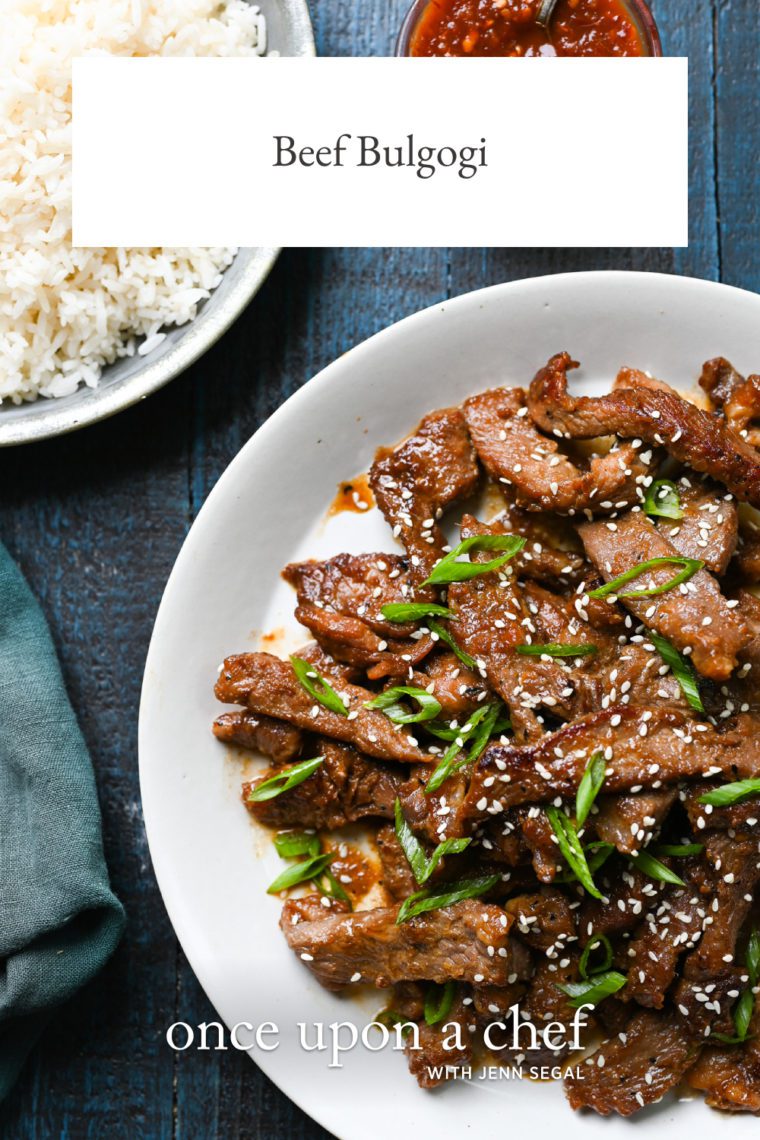

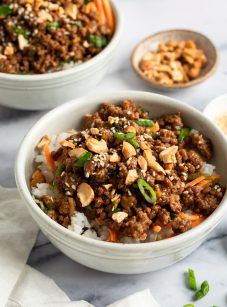
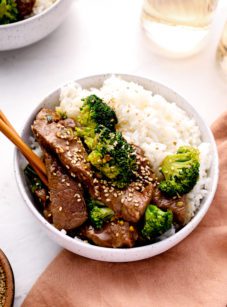
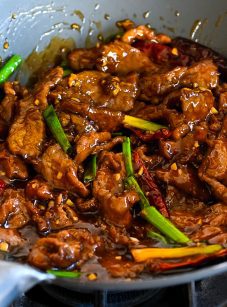

Hi Jen,
Love this dish but discovered the Thai dish “ crying Tiger “ with a lime dipping sauce. Can you post your recipe on this dish if you are inclined?
Thank you
Glad you liked it! And yes I’ll add crying tiger to my list of recipes to potentially develop! 🙂
Just purchased ribeyes to make this recipe. I know it will be wonderful just as all of your recipes are loved by my family. When I purchased, I asked butcher how to slice against grain on this cut of meat. He said I would have to slice across the meat which would be impossible. He said the grain runs differently with this cut. Being such an expensive cut of meat, I don’t wish to ruin recipe. Can you be more specific how you cut this. Butcher said just to slice thinly straight down steak from end to end because of particular cut of meat. Thank you for guidance.
Hi Jennie, The easiest way is to cut each steak into 4 pieces crosswise, freeze for about 35 min until firm, then stand each piece on one cut side on a cutting board and slice down. Does that make sense? That said, ribeye is pretty tender so if you just want to slice it normally, it will still turn out nicely!
Had some sirloin tip steaks in the freezer and pulled them out when this recipe arrived in my inbox. Sliced it across the grain while thawing. Made the marinade in about 10 mins, put it in the fridge, and then cooked it in batches a few hours later in two hot non stick frying pans. Soooo delicious! Will definitely be on my supper list rotation because it’s a top-notch recipe — easy to prep, quick to cook, and absolutely yummy! Thank you, Jenn!
I’m so happy to find this recipe. The recipe was easy to follow, it was so yummy to eat tender beef.
My Korean sister-in-law makes bomb bulgogi. So good in leftovers with bibimbap the next day too. I’ve made it often myself now too and it’s always a big hit. This is the recipe for sure. With tougher cuts, you can add pureed Asian pear or kiwi to the marinade as a tenderizer. I was also taught not to stir fry. You want as much carmelization as possible, even a little charring. I always grill it over high heat outside, unless the weather forces me to do it indoors in which case I too use a cast iron skillet on medium high heat. Just lay out the strips leaving enough space between to keep them from stewing in their juices. Do it in batches. I also usually double the marinade and set half aside (minus any tenderizer) for sauce because it’s just so good.
Hi, this recipe should (well in my opinion actually needs) GOCHUJANG (Korean hot red pepper paste – easy to find or order online). Game changer! (otherwise this is just your average beef recipe). Just toss a TBS or 2 in the marinade!
Going to try this one tonight! Did you use “perfect” jasmine or basmati rice to serve with this?
Hi Trena, I just use regular white rice. Hope you enjoy the bulgogi!
I have just added the 2 ribeye steaks to my grocery list. I happen to have a need to find more uses for the McCormick Korean-Style Red Pepper (Gochugaru) that I recently bought. I love that your recipe lists the easy-to-find already-have crushed red pepper, but I’m wondering if and how I could use the Korean Red Pepper I also happen to have at the moment. Would I use the same amount? Would it significantly change the flavor so I would need to modify other ingredients? Can’t wait to try it. Thanks for your expertise!
Hi Rhonda, it’s fine for you to use gochugaru. It’s got a slightly different flavor but it will still be good and (you don’t need to make any other modifications to the recipe). Hope you enjoy!
Hi Jenn, Thanks for your reply. I used my Korean Red Pepper and boneless ribeye steaks. I marinated overnight and followed your instructions. It got an excellent out of my adult daughter who frequents korean bbq restaurants. I personally did not find it at all spicy, but very flavorful. This will go into my recipe binder, with many of your other recipes. Thanks for making me look good.
What brand is your cast iron pan?
Hi Rob, It’s Lodge. You can find links to all my pots and pans here.
Hi Jenn, I’m going shopping for the ingredients I don’t have soon. I’m wondering what is in the little bowl of sauce that is in the picture. Is the same ingredients as the marinade?
Hi Peter, It’s chili garlic sauce – not really authentic (it’s Vietnamese) but easy to find in most supermarkets and good if you like a little heat. Traditionally bulgogi is served with ssamjang, a Korean chili sauce; you can find it (or the ingredients for it) in Asian markets and some large grocery stores. Hope that helps!
I am making this tonight can I use chicken?
Hi Mariellen, I’ve never tried it with chicken, but I think it would work. I’d suggest chicken thighs as they will be more moist.
To get the cook right you’ll want to slice or pound the chicken into thin cutlets. I’ve also made bulgogi pork. In Korea I once had bulgogi wild boar which was fantastic.